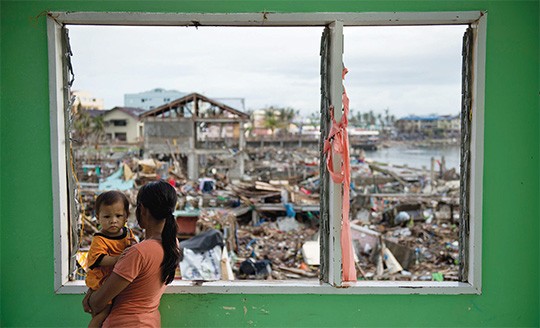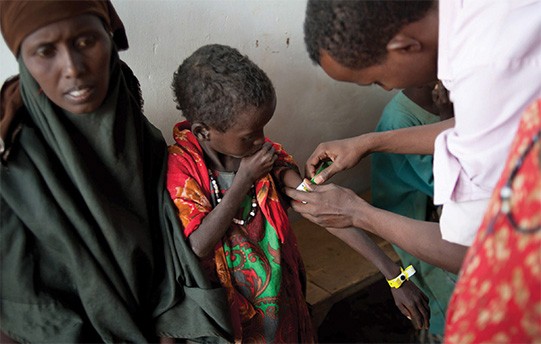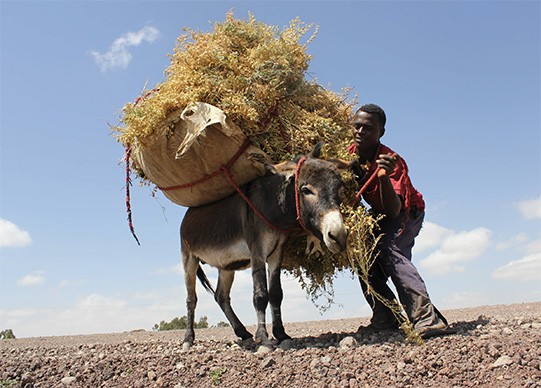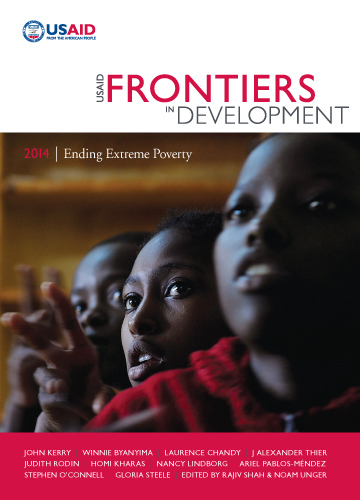Nancy Lindborg
Throughout the last 50 years, we have made steady and heartening progress in global development, achieving a string of accomplishments that many once feared impossible. Since 1990, maternal mortality rates have been nearly cut in half, as has the number of children dying before age 5. Five years ahead of the 2015 deadline, we met the Millennium Development Goal of reducing extreme poverty rates by half, and we are well within reach of cutting world hunger in half by 2015.
The number of extremely poor has fallen drastically over the last 20 years in middle-income, non-fragile states, such as China, India, Vietnam and Brazil. And with the promise of new partnerships, science, technologies and innovations, we are poised to propel global development in ways never before possible.
But by contrast, trend lines point to greater concentrations of extreme poverty in the coming decades in fragile states like the Democratic Republic of the Congo, Nigeria, Haiti, Yemen, Chad and the Central African Republic. In these countries, the number of those in poverty remains stubbornly high, and the most vulnerable populations face even greater risk.
As we look ahead to this new frontier of development, we must be ready to confront the twin punches of climate change and conflict. As climate change results in more cycles of drought and higher frequency and intensity of storms, development gains come under increasing threat. Stubborn clusters of poverty are increasingly concentrated in fragile states, where cycles of disaster and conflict are ever more persistent and devastating.
We will need to double down on our efforts to shock-proof development and make building resilience a central tenant of our development agenda by managing risk and tackling fragility.
The cost of ignoring risk and vulnerability
Climate change
In the Horn of Africa and the Sahel, what used to be 10-year drought cycles now occur every few years. Before households have time to recover, the next shock hits, setting them even further back. Communities throughout the Sahel were unable to recover from the droughts of 2008 and 2010 before the 2012 drought hit, pushing 18 million people across the region into crisis.

In 2011, the worst drought in East Africa in 60 years hit hardest in the arid drylands of northern Kenya, a historically marginalized and underdeveloped part of the country. Yet the cost of the drought was felt nationwide. The World Bank estimated an economic loss of $13.2 billion, in a country where 16 million to 18 million people still live on less than $1.25 a day.
Asia experiences more floods, cyclones and hurricanes than any other region of the world. For example, when Typhoon Haiyan—the largest recorded cyclone to hit land—struck in November 2013, it was the 25th storm in the Philippines that year, large enough to merit a name, and affected 16 million people. Every year, the Philippines loses up to $5 billion as a result of natural disasters, an amount equal to roughly 2 percent of its gross national product. As a country that still lags behind in several Millennium Development Goal benchmarks, the Philippines is not in a position to absorb losses of this magnitude year after year.
As the impact of climate change escalates, the shocks of natural disaster—droughts, floods and typhoons—come more fiercely and frequently. Recent findings from the Intergovernmental Panel on Climate Change confirm that we are already seeing the effects through variable rainfall, rising temperatures and sea levels, stronger storms and increased drought. The High Level Panel of Eminent Persons on the Post-2015 Development Agenda identified climate change as the single greatest factor that will determine whether we reach our development goals.

As we see in East Africa, in the Sahel and across Asia’s islands and cities, the effects of climate change disproportionately have an impact on the least-prepared populations: people who are marginalized—especially women—and those who are chronically poor, who are unable to survive repeated shocks and who live in areas without government capacity for preparedness and risk management.
Fragility and conflict
The shocks of climate change prove most profound in the countries least prepared to deal with them. Ample evidence now makes plain the correlation between fragility and conflict. Nearly 80 percent of the 50 countries currently affected by conflict exhibit significant levels of fragility, which USAID sees as a function of effectiveness and legitimacy in the state–society relationship. As the current arc of conflict simmering across the Sahel through Somalia demonstrates, weak, ineffective institutions, coupled with exclusive or marginalizing politics and chronic poverty, can catalyze conflict that eventually throws an entire country into chaos. According to the World Bank, one in every three development dollars was lost over the last 30 years due to reverses from conflict or disaster.
We see this explosive mix playing out all too clearly in South Sudan, where leaders have squandered the precious development gains of the last several years in their fight for political gains. The spasms of violence that began in December 2013 have plunged the new nation back into crisis. With longstanding humanitarian needs and only nascent institutions, South Sudan spiraled quickly into chaos and now faces the threat of famine in its three conflict-affected states. Similarly, during the 2011 drought across East Africa, Somalia, a collapsed state consumed by 20 years of conflict, descended into famine—and was the only nation in the region to do so.
Globally, the international community mobilizes an average of $18 billion annually for lifesaving humanitarian assistance. In nations like Thailand, Indonesia and the Philippines, a decade of disaster risk reduction efforts including strong partnerships with USAID means they have an ability to respond successfully to all but the most devastating disasters. A 10-year partnership with the Philippines to develop early warning systems and train first responders at the local and national levels in incident command response contributed to the government’s ability to evacuate 800,000 people in advance of Typhoon Haiyan, saving hundreds of thousands of lives.
With the onset of climate change, middle-income and even fully developed nations may be overwhelmed by disasters like Typhoon Haiyan and will continue to need humanitarian funding. However, the bulk of global humanitarian aid currently flows urgently and repeatedly into the same group of fragile states, where chronic poverty, often linked with persistent cycles of conflict and natural disaster, keeps millions in need of continued humanitarian assistance. These nations, all too often places with the lowest development investments, become instead a permanent humanitarian caseload.
Shock-proofing development
Over the next several decades, development and humanitarian policymakers and practitioners have the imperative—and the opportunity—to tackle this challenge together. As 2014 marks new levels of crisis and humanitarian need, we can no longer rely on humanitarian action after a crisis or disaster hits. Instead, we must shift from emphasizing only a growth-oriented model of development to one also focused on risk and vulnerability. We must break down the stovepipes to enable a shared understanding of problems and goals among humanitarian and development actors and to consistently fulfill our commitment to early, effective action in response to early warning.
USAID is committed to answering that challenge, and two approaches provide important pathways forward: the Resilience Agenda and the g7+ New Deal for Engagement in Fragile States. At the heart of both is recognition that sustained development success ultimately requires effective, inclusive democratic government partners, working together with civil society and the private sector.
Resilience
From New Orleans after Hurricane Katrina to the Philippines after Typhoon Haiyan, battered communities around the world have faced long, often painful journeys to dig out, rebuild and regain what they have lost. As these storms become more frequent, the important concept of resilience has entered the international lexicon.

Prior to the 2011 drought in the Horn of Africa, development programs in Kenya starkly illustrated a common problem: Government and donor investments focused on productive regions in the south, while the arid northern drylands received little government or international development investment. While decades of humanitarian assistance did save lives in the north, longer-term development languished.
Since 2011, USAID has been at the forefront of a global effort to transform this assistance delivery system. Our goal is to accelerate investments that help countries, communities and households get ahead of shocks; more effectively align global development partners; break down stovepipes; and support country-led resilience strategies.
In the Horn of Africa and the Sahel, we have worked closely with international development partners to support the Intergovernmental Authority on Development and the Economic Community of West African States as they provide important leadership for regional resilience efforts. As a result, countries across both regions are developing their first-ever resilience strategies. Kenya, Ethiopia, Uganda and Djibouti now all have national government platforms for mainstreaming resilience across the appropriate country ministries.
After three years, Kenya has its first resilience strategy for the arid drylands and has pledged to cover 40 percent of the costs on its own. Niger has developed a groundbreaking strategy, called Nigeriens Nourish Nigeriens, which provides ministries with a comprehensive framework for building resilience. USAID has used these country strategies to guide our new comprehensive resilience investments in the Horn of Africa and the Sahel. We have brought together sectors and partners with the common goal of building resilience so communities can withstand shocks and stay on the pathway to development.
To institutionalize and accelerate this vital shift, USAID in 2012 adopted a new policy for resilience. Drawing upon our strategies for food security, climate change adaptation and mitigation, and disaster risk reduction, resilience informs a comprehensive systems approach that layers, sequences and integrates funding and programs for humanitarian and development assistance. New USAID programs in the Horn of Africa, the Sahel and Asia have embraced this approach, reflecting a commitment within the agency to a different way of doing business.
Tackling fragility head on: the new deal for engagement in fragile states
In 2008, a set of self-identified, conflict-affected states first began work on a framework now known as the g7+ New Deal for Engagement in Fragile States. These states identified five goals for peacebuilding and state-building: inclusive politics, security, justice, economic foundations and revenues and services. The resulting New Deal, based on research by the World Bank and Organization for Economic Cooperation and Development, recognizes that security, development and governance are deeply intertwined and must be pursued simultaneously.
Countries are pledging to work with civil society and the private sector to develop country compacts based on the five peace-building and state-building goals to chart a pathway out of conflict. This is an audacious undertaking for many fragile states, and the road will be long and bumpy, but it offers a bright spot of hope.
At the Fourth International Dialogue on the New Deal in Freetown, President Koroma of Sierra Leone delivered a remarkable speech. He poignantly called Sierra Leone a “living manifestation of the maxim that ‘conflict is development in reverse’” and highlighted that a decade of bloody civil war had displaced 2.6 million people. Just over a decade later, President Koroma noted, a spirit of hope exists in the country. He credited this to a commitment to inclusive political dialogue and new partnerships between the government and civil society, to ensuring the provision of critical services to citizens, schools and clinics and to reforming the security and justice sectors. His vision is middle-income status for Sierra Leone within a generation, based on the pathway offered by the New Deal.
The new frontier of resilience
Meeting the twin challenges of climate change and conflict will be critical for preserving development gains and ending extreme poverty. In the face of mounting global humanitarian needs, these challenges demand a transformation in how we provide international assistance. Because no one organization or nation has the resources or ability to solve these challenges alone, we must continue to drive toward frameworks and platforms that align action for results in partnership with people and their leaders.
With that challenge in mind, USAID has partnered with the Rockefeller Foundation to create the Global Resilience Partnership, a bold new vision for building resilience in three zones most vulnerable to shocks: the Horn of Africa, the Sahel and South/Southeast Asia. With an initial investment of $100 million, the Partnership will work with international, regional and local partners to catalyze new ideas, amplify best efforts and align resources for helping the most vulnerable withstand the inevitable shocks and stay on the pathway to development.
We know that shocks will come from climate and political instability. We can no longer rely on simply responding to crisis after it hits; instead, our collective commitment must be to work through partnership and alliances to move from fragility to resilience. We then have the potential to maintain the incredible progress already achieved and reach the audacious goal of ending extreme poverty by 2030.
Nancy Lindborg is the assistant administrator for Democracy, Conflict and Humanitarian Assistance at USAID. The views expressed in this essay are her own and do not necessarily represent the views of the United States Agency for International Development or the United States Government.
Frontiers in Development
Section 4: Going Forward (Without Going Backward)








Comment
Make a general inquiry or suggest an improvement.